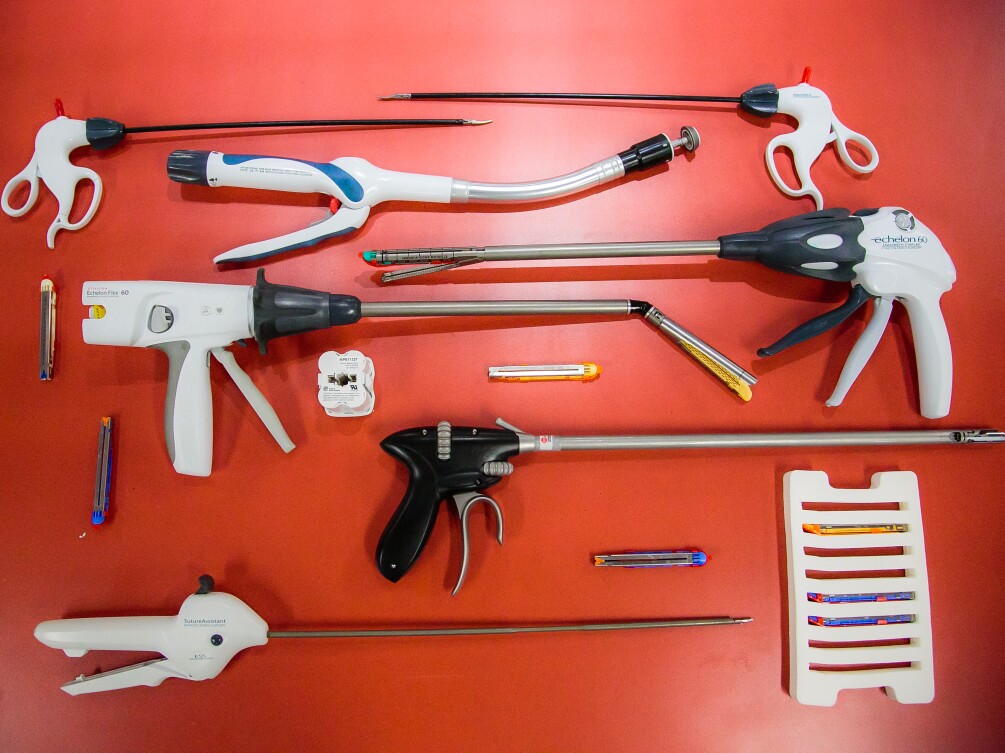Johnson & Johnson and its family of companies employ innovators worldwide who are helping to advance healthcare around the world. In this new series, “I Have the Patent for That!,” we celebrate some of the employees whose inventions are so singular that they’ve been awarded patents for their work.
“So, I’m speaking with the infamous Fred Shelton?”
That’s how one representative from the United States Patent and Trademark Office answered the phone when Frederick Shelton recently called to discuss one of his patent applications.
While she was joking when she called him “infamous,” Shelton, 49, is definitely famous in certain circles for not just the ingenuity, but also the sheer volume, of surgical tools and devices that he’s dreamed up—from adhesives to orthopedic innovations. As an R&D Engineering Fellow at Ethicon—a Johnson & Johnson Medical Devices company where he’s worked for 21 years—Shelton holds more than 700 patents and has 1,000 currently under review with the patent office.
By 2020, he hopes to have more patents than Thomas Edison.
“As an inventor, I study procedures and watch how surgeons use their tools in the real world,” Shelton says. “I try to identify where they are having trouble, or where patients aren’t getting the recovery they hope for, and then attempt to come up with new instruments that could help make things better.”
Shelton describes himself as a jack-of-all-trades, “which makes me something of an oddity in my area of engineering, where people tend to be very specialized,” he acknowledges. And that’s not the only way he’s unusual—at least by traditional corporate standards. Shelton only wears Hawaiian shirts, for instance. He’s constantly scribbling new ideas on his ever-present whiteboards, and likes to brainstorm even more breakthroughs while working on his Ohio ranch. “I have 15 full-sized donkeys and 20 miniature cows, so even the way I ranch is a little crazy,” he says.
And the results of this singularity have translated into better results for doctors and the patients they help. We caught up with Shelton to learn more about the life-changing inventions he’s had a hand in creating over the past two decades.
There are always new problems and I like to solve them like Rubik’s Cubes. I actually see coming into work as more of a vacation than the real thing.
A few of my favorite innovations ...
“There are two inventions that I’ve worked on during my career that I think have been particularly impactful. They are both surgical staplers, which are sometimes used instead of sutures because staples close wounds more quickly.
The first is the Ethicon Echelon™ 60 Endopath® Stapler. When we launched the device in 2005, it was a state-of-the-art tool that had several key strengths.
For instance, it is nimble enough to be used during laparoscopic surgery, a type of minimally invasive procedure in which only tiny incisions are made, compared to traditional surgery, where larger incisions are made. The stapler is delicate enough to fit through those small incisions, but still robust enough to secure thick tissue, like in the abdomen. The tool we built is still being sold—and widely used—today.
Then, in 2011, we launched an update to that stapler—this time with battery power, making it the first powered version of this type of device—called the Ethicon Echelon Flex™ Powered 60mm Stapler (shown at right). Initially, we manufactured 20,000 staplers that we were hoping to sell over two years. We sold out in six weeks, and went on to sell more than 270,000 in the next year.
Another interesting project I’ve worked on is an implantable device that’s absorbed into the body and helps support wound healing. This can be particularly helpful for cancer patients, whose natural healing processes can be compromised due to chemotherapy and other treatments.
I’ve also been involved in creating surgical tools that use radio frequency or ultrasonic energy to more easily enable surgeons to cut bodily tissue, while at the same time minimizing bleeding.
Diving into the future of digital surgery ...
The next wave of surgical innovation—digital surgeries—represents a giant step forward in healthcare. In these types of procedures, surgeons aspire to leverage such evolving technology as powered advanced laparoscopic devices, robotics, machine learning and enhanced visualization tools.
In 2015, Johnson & Johnson announced the formation of Verb Surgical Inc., in collaboration with Verily Life Sciences LLC—formerly Google Life Sciences—with the goal of creating a comprehensive surgical solutions platform to advance the field of digital surgery. The platform combines robotics, advanced instrumentation and data analytics to enable better patient outcomes, improve patient access to minimally invasive surgery and achieve greater hospital efficiency.
Powered advanced laparoscopic devices and robotics on this platform, for example, can offer surgeons more precision and control.
I’ve been issued many patents on surgical devices for use on robotic interfaces, and am now working to create surgical attachments for the platform.
There are so many exciting innovations and breakthroughs in the works—and with them, there will be accompanying challenges. It’s why I love coming to work. There are always new problems and I like to solve them like Rubik’s Cubes. I actually see coming into work as more of a vacation than the real thing.”








